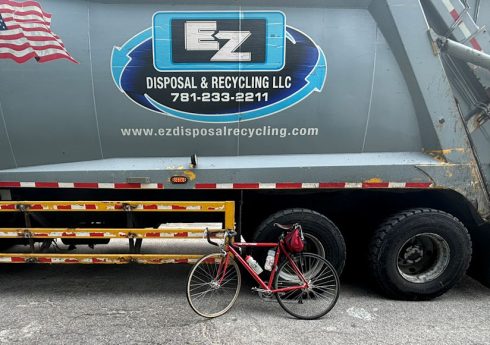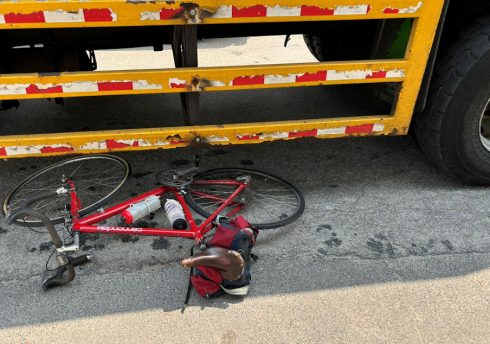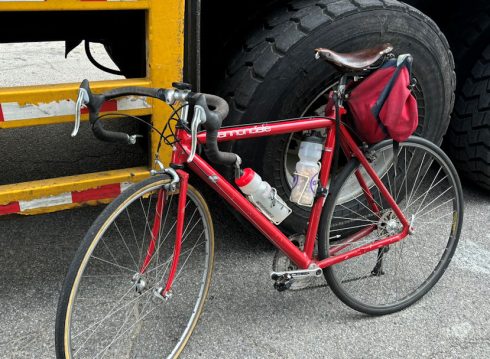No, not reliable, though some are better than others. Some are also supposed to confer an aerodynamic advantage.
Some have a smooth surface which can deflect a cyclist. That is still no guarantee that the cyclist will escape serious injury or death. Other side guards are only open frameworks which can catch and drag a bicycle. A lot of what I have seen is little more than window dressing.
The side guard in the image below from a post on the Treehugger blog has no aerodynamic advantage and could easily guide a cyclist into the rear wheels of the truck.
A cyclist can easily go under the side guard shown in the image below, from a Portland, Oregon blog post. A cyclist who is leaning against the side guard is guided into the fender bracket and fender, and the front of the turning wheel, which can pull the cyclist down. There is another wheel behind the one in the photo.
The side guard on a Boston garbage truck in the photo below — my own screen shot from the 2013 Boston Bikes annual update presentation — is only an open framework which could easily catch and drag a bicycle.
A truck which is turning right off-tracks to the right. A cyclist can be pushed onto his/her right side, and goes under, feet to the left, head to the right. Or, if an overtaking truck contacts the left handlebar end, or if the right handlebar end contacts a slower or stopped vehicle or other obstruction, the handlebar turns to the right and the cyclist slumps to the left, headfirst.
To be as effective as possible for either aerodynamics or injury prevention, side guards must cover the wheels. Though that is practical, none of the ones shown do.
But no practical side guard can go low enough reliably to prevent a cyclist from going underneath. The side guard would drag at raised railroad crossings, driveway aprons, speed tables etc. Even if the side guard did go low enough, it would sweep the fallen cyclist across the road surface, possibly to be crushed against a parked car or a curb.
Below are three photos which sanitation workers were kind enough to let me take. First a wide view. My bike was on the left side of the truck, as the workers were busy on the other side.

Next, the bicycle under the truck as it would be if pushed over and the truck was steering in its direction.

And finally, a bicycle guided along the side of the truck, with the handlebar sliding against the side guard. If the truck is going faster than the bicycle, this would steer the front wheel away from the truck and topple the cyclist into the truck’s rear wheels headfirst. The handlebar end could also be hooked by the vertical bar at the end of the side guard, dragging the bicycle while the rider is dumped onto the wheel.

Fatalities have occurred when cyclists went under buses, which have low side panels — but the wheels are uncovered. The Dana Laird fatality in Cambridge, Massachusetts is one of two in the Boston rea of which I know. When the handlebar strickes a stationary or slower object on the opposite side from the moving truck or bus, the rider will topple into the truck or bus. Ms. Laird’s right handlebar end is reported to have struck the opening door of a parked vehicle, steering her front wheel to the right and toppling her to the left.
The bicycling advocacy community, as shown in the blog posts I’ve cited, mostly offers praise and promotion of sub-optimal versions of side guards, a measure which, even if executed as well as possible, offers only a weak, last-resort solution to the problem of truck underruns.
Most of the comments I see on the blogs I linked to consider it perfectly normal for motor traffic to turn right from the left side of cyclists, and to design infrastructure — bike lanes in particular — to formalize this conflict. The commenters also would like to give cyclists free rein to overtake close to the right side of large trucks, and place all the responsibility on truck drivers to avoid off-tracking over the cyclists. Side guards do not remove the need for defensive driving either for bicyclists or for motorists.
Cyclists are vulnerable road users, but vulnerability is not the same as defenselessness. It is rarely heard from today’s crop of bicycling advocates, but a cyclist can prevent collisions with trucks and buses by not riding close to the side of them. There’s a wild contradiction in playing on the vulnerability, naiveté and defenselessness of novice cyclists to promote bicycle use with measures — particularly, bike lanes striped up to intersections — which lure cyclists into the death trap next to a truck or bus. Regardless of whoever may be held legally at fault in underrun collisions, cyclists have the ability to prevent them, and preventing them is the first order of business.
Want to learn how to defend yourself against going under a truck? Detailed advice on avoiding bicycle/truck conflicts may be found on the CyclingSavvy Web site.
Additional comments about the political situation which promotes underrun collisions may be found on the CommuteOrlando site.





John, I don’t know whether to laugh or cry when I hear that cycling advocates are singing the praises of truck side skirts as a way to keep cyclists from being killed by trucks. That’s a little like poking a grizzly bear and proclaiming that bear spray will keep you safe.
Vulnerability is neither the same as defenselessness nor the same as riding stupid. Unfortunately, some of today’s so-called cycling advocacy suggests that riders should do both–ride defenselessly and stupidly. Much of Streetsblog’s philosophy is an excellent example.
Many of us have been sharing the road with trucks, including eighteen wheelers, for decades. Its not rocket science to know how to do so, either. Riding up into a truck’s blind spot where it might be making a right turn seems an excellent definition of a daft cyclist–or a daft urban planner, if the planner advises to do so.
As has been discussed elsewhere, I find this a sad bit of “fifth layer” (or perhaps we need to create a sixth layer) of injury-reduction gear.
‘Tis far better to not need such things, via education of riders, policy-makers, and even advocates, of course, but to allow them to be so poorly designed as to make things worse borders on criminal.
I sometimes muse that to earn a driver’s license, one must spend time in a simulator to get a feel for driving a semi, just to learn about blind spots. It would (hopefully) cut down on the number of people who do stupid things around big trucks, including a fair number of cyclists.
Of course, I then remember that a) many bicycle users will continue to think that their bicycle is neither fish nor fowl (or car or stroller), b) actual driver education is an anathema to many in modern society who feel that a driver’s license is a right rather than a privilege.
http://labikes.blogspot.com/2013/07/bear-spray-truck-side-guards-and-safety.html
I just returned from riding the Bon Ton Roulet in the Finger Lakes, NY. We rode on 5/20 which had a lot of truck traffic. I noted that the trucks with side skirts had less wind gust than those without the skirts. I feel that these side skirts reduce the risk of falling due to the wind gusts from passing trucks. By the way, I do appreciate the wide, well-maintained shoulders on NY county and state routes. Unfortunately, the phenomenon of motorists passing too closely when we’re on the shoulder was prevalent.
Good point, Tricia. Side skirts are usually thought of as a way to prevent cyclists from going under trucks, and as I describe in the blog post, they can’t be fully effective in doing that. As you point out, the aerodynamic ones reduce wind buffeting. That’s quite different, a win-win.
Pingback: Police repression of cyclists in Montreal | John S. Allen's Bicycle Blog
I researched bus skirts in 2003, following the tragic death of Susie Stephens, first Executive Director of the Thunderhead Alliance (since 2009 the Alliance for Biking and Walking), in downtown St. Louis. (See description I wrote of that event, now on-line at http://cycling.mohiking.com/susiestephens.html.)
Susie was walking back to a Thunderhead Alliance meeting and was legally in the crosswalk leading to the hotel on a walk signal when she was run over and killed by a left-turning charter bus used to pick up and drop off hotel guests. It turned out a left-turn arrow for vehicles was green simultaneously with the walk signal, and the bus driver failed to see Susie Stephens. (After this fatality that left-turn signal was covered by the City of St. Louis.)
I found one company which offered what looked like a well-engineered solid panel secured between the front and back bus wheels that ended close to the ground. In a supporting video the panel was shown very convincingly pushing a dummy out of the way of the rear wheels. My efforts to get the private bus company to consider adding these devices or the City of St. Louis to require them were unsuccessful. I seem to recall cost being a primary factor.
I cannot find my notes to confirm the above, or even the name of the manufacturer, so this is purely from (sometimes faulty) memory.
The underlying problem was the simultaneous walk signal and left turn signal. That sets up the crash.
The comment below was intended to be posted under a blog post on Treehugger and praising China for requiring side skirts. I was replying in response to another commenter who signs his/her name in Chinese. My comment was moderated, possibly because it contained a link to this post on my own blog.
***********
“It’s impossible to get data.” I’d hope that China does collect data, and is willing to make it public. I don’t have much hope though for data about a questionably effective program of an authoritarian government, and apparently, neither do you.
“I forgot to add, people still get squashed.” While well-designed side guards — smooth and extending almost to the ground — reduce wind buffeting of cyclists and also save fuel, no practical side guard can prevent the truck from knocking over a cyclist, who may then still go underneath. These side guards don’t look like a very good design to me. They are open frameworks which can snag handlebars, and they don’t cover the rear wheels of the trucks. If the truck is overtaking a cyclist, the impact turns the handlebars to the right, the cycle falls to the left and the cyclist’s head very likely gets pulled down by the front of a turning tire.
Trucks’ colliding with cyclists is mostly a behavior problem and an infrastructure problem. Cyclists must know not to overtake into the path of turning trucks; and infrastructure must not require or encourage that. Side guards, even better ones, are only a last resort.
I’ve written more about this on my on blog: [URL of this post].
Pingback: Rubber Baby Bumpers
Pingback: Sideguards to be made mandatory for all trucks doing business in Boston – qwe
Pingback: My opinions on the bills before the Massachusetts General Court | Street Smarts
Dear John,
last Thursday, November 3, 2016, in the evening, a tragic almost 1:1 copy of the 2002 Dana Laird fatality happened in the city of Leipzig, Germany:
It happened at the inner city street ‘Goethestraße’, which has reduced motor vehicle traffic, but is run by four tram lines, each circulating every 10 minutes per direction at daytime.
A 48 year old female cyclist had to swerve left to avoid a suddenly opened door of a parked motor vehicle, was overrun by a following tram car where the driver could not brake anymore, meaning killed immediately.
At that street, no dedicated bike lane is marked, and the motor vehicle traffic is not so intense that a bike lane would create a significant benefit for cyclists, but the space between parking vehicles (even with closed left door) and the tram tracks is rather narrow, I think not more than 1 meter (3 1/2 ft) between motor vehicle and a passing tram car:
https://goo.gl/maps/PDrGkycfNpN2
For this reason, tram drivers mostly avoid to overtake cyclists anyway at this section of the street.
In the recent years, in several streets in Leipzig, indeed bike lanes are marked in the same style as in Massachusetts Avenue, Cambridge, some with not much more safety space from parking vehicles than there.
Leipzig currently has 580,000 inhabitants, rapidly increasing (600,000 are expected at christmas 2017), with almost 40,000 students. Annually, one or two cyclists are killed in the street, mostly by a truck turning to the right, having had the cyclist in the blind spot.
While contacting the local city traffic authority for some public discussion of bicycle politics, with cc to the local press, I cited your analysis of the Dana laird fatality
http://www.bikexprt.com/massfacil/cambridge/doorzone/laird1.htm
already several years ago, even when being aware that most of the east Germans born before 1980 have rather poor English language skill.
(I have ‘immigrated’ to Leipzig from West Germany in 1994, being learning English since 1975, so having a language skill level of at least B2 = Upper intermediate if not C1 = pre-advanced).
In summary, I want to earnestly thank you for your effort in urban bicycle politics, in the hope that more city authorities may learn from you, to save health and lives of future generations of cyclists.
Best regards,
Burkhard
Pingback: Window dressing – bostonbiker
Pingback: My opinions on the bills before the Massachusetts General Court – bostonbiker